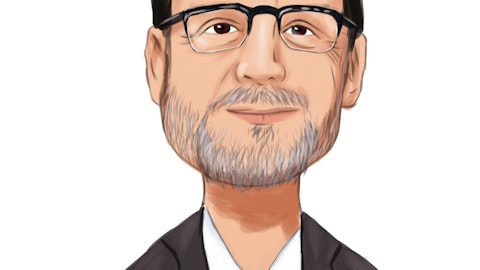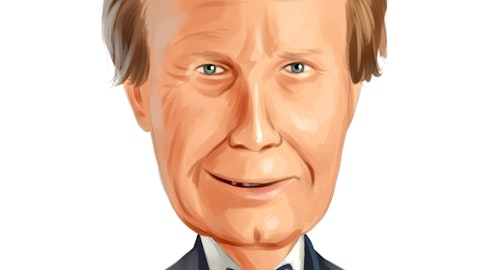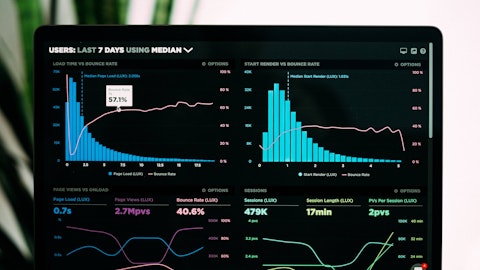Hanmi Financial Corporation (NASDAQ:HAFC) Q4 2022 Earnings Call Transcript January 24, 2023
Operator: Ladies and gentlemen, welcome to the Hanmi Financial Corporation’s Fourth Quarter and Full Year 2022 Conference Call. As a reminder, today’s call is being recorded for replay purposes. I would now like to turn the call over to Larry Clark, Investor Relations for the company. Please go ahead.
Larry Clark: Thank you, Doug, and thank you all for joining us today to discuss Hanmi’s fourth quarter and full year 2022 results. This afternoon, Hanmi issued its earnings release and quarterly supplemental slide presentation to accompany today’s call. Both documents are available on the IR section of the company’s website. I’m here today with Bonnie Lee, President and Chief Executive Officer of Hanmi; Anthony Kim, Chief Banking Officer; and Ron Santarosa, Chief Financial Officer. Bonnie will begin today’s call with an overview and Anthony will discuss loan and deposit activities. Ron will provide details on our financial performance and then Bonnie will provide closing comments before we open the call up to your questions.
Before we begin, I would like to remind you that today’s comments may include forward-looking statements under the federal securities laws. Forward-looking statements are based on current plans, expectations, events and financial industry trends that may affect the company’s future operating results and financial position. Our actual results may differ materially from those contemplated by our forward-looking statements, which involve risks and uncertainties. Discussion of the factors that could cause our actual results to differ materially from those forward-looking statements can be found in our SEC filings, including our reports on Forms 10-K and 10-Q. In particular, we direct you to the discussion of certain risk factors affecting our business contained in our earnings release, our investor presentation and in our Form 10-K.
With that, I would now like to turn the call over to Bonnie Lee. Bonnie, please go ahead.
Bonita Lee: Thank you, Larry. Good afternoon, everyone. Thank you for joining us today to discuss our third quarter 2022 results. 2022 was a year of solid execution and record earnings for Hanmi. We continue to strengthen and diversify our business by executing our well defined strategies, enabling us to finish the year with a strong momentum. This strategic model, coupled with our ongoing dedication to customer service, underscores our proven ability to navigate dynamic macroeconomic conditions and deliver strong results. For the year, we generated record net income and loan production and an improved net interest margin, all while diligently managing our operating expenses and improving our asset quality. Let me review the highlights.
Net income for the year was a record $101.4 million, or $3.32 per diluted share. Loans grew by 15.7% in 2022, driven by record new loan production of $2.1 billion. Net interest income for the year increased by 21.8% as a result of a higher average earnings assets and a 42 basis point increase in our net interest margin to 3.50%. Our deposits grew by 6.6% for 2022, which helped fund our loan growth, and the mix of non-interest bearing deposits remained strong at 41.2% of total deposits. We managed our non-interest expenses diligently. They increased by less than 5% for the year, and we recorded a full year efficiency ratio of a 47.93%, a 608 basis point improvement from 2021. Importantly, asset quality improved significantly in 2022 as we continued our focus on high quality loans, disciplined underwriting and vigilant credit administration practices.
As a result, nonperforming assets declined 29% to $10 million or 0.14% of total deposits. Criticized loans were down 20%, and net charge-offs were negligible over the course of the year. Last, our 2022 return on average shareholder equity was strong at 14.83%. We increased our shareholder dividend twice this past year 25% year-over-year in recognition of our improved performance and our capital ratios remained very strong, positioning us well for continued growth in a safe and sound manner. Our team delivered meaningful progress on each of our strategic growth initiatives. We further diversified our loan portfolio, strengthened our relationships with existing customers, expanded our customer base, bolstered our core deposit franchise. Our commitment to exceptional customer service is the hallmark of our community banking approach, and in tandem with our focus and hard work, enabled us to achieve these results.
As we have discussed in the past, diversifying our loan portfolio has been a key priority over the last two years, and we made excellent progress in 2022. For example, our residential mortgage loan production was a record $421 million for the year and represented approximately 20% of our total loan production, well exceeding our ramp-up targets of 10% to 15%. Our SBA group also generated another strong year of production originating $209 million of loans for the year, driven by a keen focus on expanding market reach and securing new talent and we continue to gain solid traction with our Corporate Korea initiative, where both loans and deposits grew meaningfully. As a reminder, this initiative focused on the needs of US divisions of South Korea-based businesses and serves to diversify our portfolio with high quality loans.
Here, loan balances were up $145 million or 23% for the year, and deposit balances grew $230 million or 59% and now representing just over 9% of our total deposits. In addition to the diversification achieved in our loan production and loan categories, nearly 12% of new commercial real estate and C&I loan production for the year came from outside California, up from 7% last year. We saw strong growth in Texas in our Eastern region, reflecting both the healthy market conditions as well as our continued success in attracting new customers in these markets. The results are clear; our loan diversification strategies are working. Our asset quality remains very strong as we have been proactive in communicating with our customer about their businesses.
We want to understand the challenges they may see on the horizon and work together to help them navigate this uncertain macroeconomic environment. Communication with our customers is a critical part of our approach, both in gaining new business and in maintaining existing relationships. With that, I’ll turn the call over to Anthony Kim, our Chief Banking Officer, to discuss fourth quarter loan production and deposit gathering in more detail.
Anthony Kim: Thank you, Bonnie. I’ll begin with additional details on our loan production where fourth quarter volumes were $474 million, down modestly from the third quarter and, we believe, reflecting the current environment of higher interest rates and economic uncertainty. We achieved higher sequential production in commercial and industrial, SBA and equipment finance and while our residential mortgage production was down from its record volume in the third quarter, we originated $107 million of loans during the fourth quarter, a very good result in a challenging mortgage environment. Our focus in the residential mortgage division is on the non-QM market, and our correspondent lenders in this market remain active. A large portion of our production continues to be for home purchases rather than refinances.

Photo by Gabrielle Henderson on Unsplash
The purchase market remained relatively healthy in the fourth quarter as many homebuyers were eager to close on their homes and lock in their rates. However, we do expect mortgage originations to moderate in 2023 as higher interest rates are having an impact on both the purchase and refinance markets. C&I funding was $138 million during the quarter. Total commitments on commercial lines of credit increased to $1 billion at quarter end, up $56 million or 5.7% from the prior quarter and up 34% year-over-year. Outstanding balances on these lines increased by 6% between quarters, resulting in a fourth quarter utilization rate of 40%, consistent with the third quarter. Equipment finance production was strong again at $89 million for the fourth quarter, up from $86 million in the third quarter.
And SBA 7(a) loan production was $53 million for the fourth quarter and continues to perform in line with our expectations. Our investment in loan production personnel over the last year and half has enabled us to continue to service this key market. With respect to our Corporate Korea Initiative, as Bonnie mentioned, we delivered strong loan growth for the year, which was driven by $187 million of new production. We did see a decline in production for the fourth quarter given the higher level of economic uncertainty that is impacting our customers. However, we remain optimistic about this important line of business and expect 2023 to be another good year for us. Our Corporate Korea portfolio is well above the level we had expected for this business as loan balances were $781 million at year-end, representing 13% of our total loan portfolio.
The average rate on all new loan production for the fourth quarter was 6.85%, up 130 basis points from the third quarter. Payoffs were $121 million for the quarter, down from $140 million for the third quarter. The average rate on loan payoffs was 6.27%, up 101 basis points from our third quarter payoffs. This is the second quarter in a row where new origination yields have exceeded the yields on loan payoffs, which should benefit our future average loan yields. In summary, our efforts to further diversify our loan portfolio by industry, geography and loan type is working, which we believe will drive incremental growth and profitability. Now turning to deposits; excuse me, deposits remained relatively stable during the fourth quarter, down less than 1% from the prior quarter.
We did see a shift in the composition of our deposits during the quarter, as some deposits in DDAs, money markets and savings accounts moved understandably into time deposits given the rapid increase in interest rates. Notwithstanding these moves, noninterest-bearing DDAs represented just over 41% of our total deposits at year-end, which we believe validates our strong customer service and local market expertise. We also had continued success with our deposit gathering efforts with our new and existing Corporate Korea clients as those deposit balances grew modestly in the fourth quarter. At year-end, our Corporate Korea deposits were $575 million, up 59% from the prior year and represented just over 9% of our total deposits. And now I’ll hand the call over to Ron Santarosa, our Chief Financial Officer, for more details on our fourth quarter financial results.
Romolo Santarosa: Thank you, Anthony. Beginning with net interest income at $64.6 million for the fourth quarter, we saw a 2.3% sequential growth from the third quarter. This increase primarily reflected the increase in average loans, while the increase in the cost of interest-bearing deposits essentially offset the increase in average loan yields. Average loans reached $5.88 billion for the fourth quarter, up 3.2%. The cost of interest-bearing deposits rose 92 basis points to 1.7% and the yield on loans was 5.21%, up 54 basis points. Turning to our net interest margin, which was 3.67% for the fourth quarter and up one basis point from the prior quarter; we saw the increase in loan yields benefited our net interest margin by 48 basis points, while the increase in the cost of interest-bearing deposits reduced that benefit by 46 basis points and there was a negative one basis point differential between the increase in yields on other interest-earning assets and the cost of borrowings and debt.
During the fourth quarter, we saw a 125 basis point increase in the federal funds rate, 425 basis points for all of 2022 and extraordinary acceleration of interest rates in a very short period. Expectedly, the interest rates offered on our loan and deposit products have also increased and as we saw, depositors renewed their interest in time deposits. Turning to our various betas for the fourth quarter; our interest-bearing deposit beta for the fourth quarter was approximately 62%, while our loan beta was approximately 37%. As we have previously noted, the beta in any particular quarterly period can vary significantly given the amount of the change in the federal funds rate for that period as well as differing market conditions for that period.
As such, we continue to remain cautious as to the quarterly trajectory of the net interest margin given the current uncertainty in interest rates and the economy. That said, we are very pleased with the performance of our net interest revenues and net interest margin through this stage of the rising rate cycle, especially given the support from our high level of noninterest-bearing demand deposits. Moving on; noninterest income was $7.5 million for the fourth quarter, down from $8.9 million for the prior quarter, due primarily to a $600,000 decline in other operating income and a $300,000 decline in our SBA gain on sales. The decline in other operating income was primarily due to a $500,000 decrease from the third quarter where we had a gain on the disposition of a lease residual.
The volume of SBA 7(a) loans sold for the fourth quarter decreased modestly to $40.9 million, and trade premiums, as expected, declined 10% to 5.99% for the quarter. Last, we recognized a $300,000 valuation adjustment to our bank-owned life insurance asset. With respect to expenses, noninterest expenses for the fourth quarter were up $600,000 from the third quarter, with some categories increasing and others declining. Salaries and employee benefits increased by $900,000, reflecting primarily adjustments to incentive compensation from our strong loan production and financial performance, changes in activity levels contributed to the $500,000 increase in professional fees and a $200,000 decrease in advertising and promotion. Occupancy and equipment expenses was $1 million lower in the quarter, largely due to adjustments to real property taxes on leased and owned premises.
In addition, other operating expenses were higher by $300,000 due to a valuation adjustment on our servicing assets. As a result, our efficiency ratio for the fourth quarter increased slightly to 46.99%. We recorded a provision for credit loss expense of $52,000 for the fourth quarter, down from $600,000 for the third quarter. Fourth quarter expense reflected a positive loan loss provision of $200,000 and a negative off-balance sheet provision of $100,000. The allowance for credit losses was $71.5 million at year-end, representing a coverage ratio of 1.2%. Compared with the third quarter, our specific allowances increased $1 million, while the allowance for quantitative and qualitative considerations decreased by $1.1 million. In summary, we delivered another strong quarter with net income of $28.5 million or $0.93 per diluted share, a return on average assets of 1.56% and a return on average equity of 15.9%.
For the full 2022 year, our return on average assets was 1.44% and our return on average equity was 14.83%. The company and the bank exceeded minimum regulatory capital ratios, and our ratio of tangible common equity to tangible assets was 8.5%, up from the prior quarter because of net retained earnings for the quarter as well as a positive adjustment to the unrealized after-tax loss on our securities portfolio arising from a decrease in longer-term interest rates. Consequently, our tangible book value per share was up 4.8% from the third quarter to $20.54. With that, I will turn it back to Bonnie.
Bonita Lee: Thank you, Ron. I believe this past year and in the years before that, we have demonstrated our ability to navigate volatility, and we’ll continue to do so with a keen focus on the execution of our strategic plan. We entered 2023 with a strong balance sheet. Looking ahead, we anticipate that loan production will moderate from the levels we saw in 2022 due in large part to the current elevated interest rate environment and uncertain macroeconomic backdrop. We are approaching this dynamic environment with caution and discipline. We remain vigilant in our underwriting and credit administration. We remain focused on growing our core deposit base by continuing to win customers and expand our existing corporate relationships.
And we remain committed to our communities and the Hanmi team, all with the goal of delivering attractive returns to our shareholders. With that, I want to thank the entire Hanmi team for their exceptional work this past year. We just celebrated our 40th anniversary, an important milestone for our company. Our teams reflect the communities we serve in enabling them to bring a deeper understanding of our customers’ needs. They are our competitive advantage and with them, we look forward to many more decades of delivering personalized relationship-based service with a continued commitment to helping our customers reach their financial goals. This is how we intend to continue generating positive results for our customers, our communities and our shareholders.
Thank you. We’ll now open the call for questions. Operator, please open the line up to the questions.
See also 10 Dirt Cheap Stocks To Buy and 13 Cheap New Stocks To Buy.
Q&A Session
Follow Hanmi Financial Corp (NASDAQ:HAFC)
Follow Hanmi Financial Corp (NASDAQ:HAFC)
Operator: Our first question comes from the line of Kelly Motta with KBW. Please proceed with your question.
Kelly Motta: Hi. Good evening. Thanks for the question. I think I’ll start with the deposit side. We’ve seen a few of your peers report so far, and betas are clearly accelerating, but you were still able to keep your margins pretty flat this quarter, which is great. Just wondering if you could provide some commentary on maybe spot deposit rates at 12/31 as well as what you’re expecting for betas and vis-Ã -vis how that should read through into the margin in the next couple of quarters here.
Romolo Santarosa: Well, thank you, first of all. And I just want to acknowledge the hard work of Anthony and the team in managing our deposits, not only in their growth, but in the rates that we pay. It’s a very competitive marketplace and I think our beta reflects the discipline and determination that Bonnie had mentioned. So with that, I can plainly tell you that the cost of our interest-bearing deposits through January, for the month, are about 70 basis points higher than the quarterly average that we experience. So how that translates into a beta, I truly don’t know. We’re going to be up against perhaps two more rate increases. What I can say is that I think we’ve demonstrated again over the past few quarters that we take to heart what our depositor needs are, but also what our financial performance needs are and we navigate the best we can through those hurdles and when we meet again in the first quarter, I’ll let you know what our beta is.
Kelly Motta: Thanks Ron. Just stepping back on deposits, just at a high level; noninterest-bearing, you had some runoff this quarter, but they’re still over 40% and pre-pandemic, you were more around 30%. Just on a high level, anything like structural that would dictate having a higher level of noninterest-bearing? Maybe it’s Corporate Korea or — and those sorts of initiatives, but just wondering on what you view as kind of the run rate of noninterest-bearing deposits as part of your mix here with what you’ve done in the past couple of years. And how much do you anticipate kind of sticking around as liquidity post COVID starts to run through?
Bonita Lee: Thanks. So let me try to answer that. So definitely, last couple of quarters, we did see outflow of DDA going into the interest-bearing deposit category. And I still think that speed of — the velocity of the outflow will slow down. And our strategy has been very consistent that we go after — we target market and the corporate deposit accounts, and we’ve been very successful, whether that has been Corporate Korea Initiative or corporations within the US. So that strategy will continue to stand.
Kelly Motta: Okay. Thanks. I will step back.
Operator: Our next question comes from the line of Matthew Clark with Piper Sandler. Please proceed with your question.
Matthew Clark: Hey. Good afternoon. Thanks. Maybe first just on running out the margin outlook discussion; Ron, if you had the average margin in the month of December?





